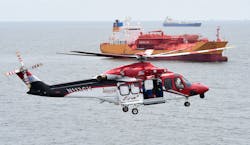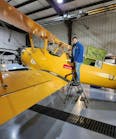Helicopters, by their very nature, are very complex machines demanding exacting engineering standards both in manufacture and with maintenance. Because of the unique capabilities, they are often used within challenging and hostile environments in activities with relatively high-risk exposure. Added to this are the risks of operating single-engine operations over hostile terrain or at night.
Across a number of developing areas of the world, the regulatory oversight of aircraft operators varies considerably and should not be relied upon as a sole source of safety assurance for organizations providing outsourced aviation support.
The Flight Safety Foundation, in conjunction with the resources sector, introduced the first version of the Basic Aviation Risk Standard back in 2010. This was followed by a number of updates and enhancements where we are currently at version number five. An Implementation Guidelines document was introduced to complement the standard and this provides additional details on what is expected to be established to meet the requirements of the relevant controls. This is a valuable resource tool for aircraft operators, auditors, and end users of contracted aviation services.
BAR Standard for Offshore Helicopter Operations (BARSOHO)
In response to a need from a number of organizations, a dedicated BAR Standard for Offshore Helicopter Operations (BARSOHO) was introduced along with its own companion Implementation Guidelines document. These documents were produced in conjunction with recognized industry experts to meet the needs of aviation risk in this unique sector. Version 6 of all of these documents will be released progressively during this year.
The threats and associated controls that appear within both the onshore and offshore versions of the standard were essentially borne of the lessons learned from past aviation accidents. These threats and controls apply to both airworthiness and flight operations.
An examination of some of the maintenance elements contained within the BARSOHO may prove useful in the context of maintenance and airworthiness.
Common controls 1.1, Safety Leadership, and 1.2, Safety Management Systems, are fundamental elements that should not only exist but be endemic with any reputable organization providing aviation support. Where demonstrated, a fully integrated SMS is a demonstration of a highly mature organization with robust and effective safety systems in place.
Common control, 1.11, Fatigue Management, is particularly important where maintenance tasks may be carried out very early in the morning or very late in the evening. It is crucial where these tasks are carried out on a 24-hour basis. Human factors training is also complementary to this control and is covered under common control 1.10, Maintenance Personnel Competence. Understanding why humans are prone to errors and the circumstances under which these arise is critical to the process of risk mitigation. This is particularly important with helicopters given their critical complexity.
Common control 1.9, Continuing Airworthiness Management, is vital to ensuring that an aircraft is safe and airworthy for the mission and environment within which it is operating. These take place over remote and hostile terrain including over water. It is more than simply ‘hands on maintenance tasks’.
Control 8.2, Engine Usage and Trend Monitoring, and Control 8.3 Engine/Powerplant Modification Standard and Maintenance Procedures. Irrespective of whether you are operating single or twin-engine helicopters, if you operate offshore or over any hostile environment, continuing airworthiness policy and monitoring systems are critical at minimizing engine power loss.
Control 8.4, Vibration Health Monitoring/Health and Usage Health Monitoring. This is proving to be invaluable technology in detecting the onset of probable technical failure before it actually happens. It is also an excellent means of trend monitoring prior to scheduled maintenance periods. These types of systems were first developed during the early 1990s to assist in the identification of airworthiness related failures and relied on the storage of data to PCMCIA cards from which information was downloaded and assessed. Whilst this type of data capture and retrieval still exists, the continuing development has seen a broader range of information captured which may be processed on board the aircraft or downloaded for analysis on the ground. HeliOffshore, an organisation representing the interest of offshore helicopter operators, has recently produced an excellent document titled ‘HUMS Best Practice Guidance’.
Control 8.5, Critical Maintenance Tasks and Independent Inspections. The three brief case studies included with this article highlight the importance of this control. Although independent inspections of certain critical tasks may not always be mandated by the regulatory authority for certain categories of operation, the control is required under the standard in recognition of the value of this control as a defense.
Although completion of a BARS audit provides aviation clients who are members of the program with an accredited and independent audit report to an international, industry standard, an aircraft operator doesn’t have to undergo a BARS audit to take advantage of this valuable resource material. The suite of BAR Standards, together with their accompanying Implementation Guidelines documents, are freely available for download from the Flight Safety Foundation website. When implemented by an aircraft operator, such as Control 8.5, they can become a key mitigation of risk whether required by regulation or not.
Helicopter operators in the program
There are currently 29 helicopter operators who are formally a part of the BARS program. This means that they have undergone a formal BARS audit and are registered on the BARSoft system for member clients, such as the mining and offshore sectors, to access. This also means that they have demonstrated that they comply with the requirements of the program by having these controls in place. Each of these BARS registered aircraft operators perform either onshore or offshore aviation support activities, in some cases, both.
Effective safety management systems and industry-based standards, such as BARS, have made a tangible contribution to aviation safety. Where an aircraft operator does not have a control in place prior to a BARS audit, they certainly do to attain a successful completion of the audit. For those aircraft operators who have not undergone a BARS audit, you can still take advantage of the benefits of the standard by self-application of the controls from the standard. The brief case studies included with this article attest to that.
With the incremental increase in the application of controls such as those in the BAR Standard, comes an incremental increase in safety for the industry. From this, everyone benefits. More can be found at http://flightsafety.org/bars/bar-standard.
About the author: Greg Marshall is the vice president Global Programs for the Flight Safety Foundation.
NOTE - 3 SIDEBAR ACCIDENT CASE STUDIES
Case Study 1 – BARSOHO, Control 8.5, Control 8.3
On Jan. 1, 2014, an EC130B4 helicopter was being flown on a post-maintenance check flight. When on short final to Boulder City Municipal Airport, Nevada, at approximately 200 feet above ground level and at an airspeed of 40 to 50 knots, the engine flamed out.
The pilot lowered the collective to initiate an autorotation but was not able to successfully complete the landing. The tail boom touched the ground first and a hard landing ensued. The pilot was uninjured but the helicopter sustained substantial damage.
An inspection of the wreckage noted that the main fuel supply line B-nut fitting was found without the safety wire and the nut was loose when turned by hand. Before the accident flight, the line had been disconnected during a task to replace the bidirectional suspension cross-bar assembly and the accident flight was the first since the task was performed.
According to the noncertified maintenance technician who performed the task, the line was removed to defuel the fuel tank which was contrary to manufacturer's maintenance manual procedures.
It is likely that the B-nut fitting was not properly tightened and safety-wired during reassembly.
(Source: NTSB, Aerossurance)
Case Study 2 – BARSOHO, Control 8.5
On Nov. 9, 2013, an EC135P1 helicopter was being flown on a post-maintenance check flight with a pilot and two mechanics on board. All received minor injuries following a loss of control in flight incident and attempted an autorotation landing in a field. The helicopter landed hard and rolled on to its right side.
The investigation found that the anti-torque pedals had separated from the anti-torque levers. A review of he helicopter’s logbook found that a mechanic had performed an action to “disassemble, inspect, and reassemble tail rotor pedals.” This was associated with an 800-hour check and scheduled engine change. After the accident, an inspection of the maintenance area located a small parts bag tied to the tail rotor control cable that had been replaced. Inside the bag were bolts similar to the bolts used to secure the anti-torque pedals.
The scope of work had originally been scheduled for four to six weeks however pressure from a customer dictated that this be shortened to the minimum time needed to complete the inspections and any repair needed to ensure airworthiness. Together with staff shortages, this created a working environment where maintenance personnel were continually required to work between a number of aircraft undergoing maintenance at the same time and precluded continuity.
It was evident that an independent inspection was not conducted. Further evidence suggested that no independent inspections were occurring. Whilst these may not always be required for certain aircraft, the lack of duplicate inspections removes a valuable defense, especially when subject to schedule pressure.
(Source: NTSB, Aerossurance)
Case Study 3 – BARSOHO, Control 8.5
On Dec. 7, 2011, an AS350B2 helicopter was operating on a sight-seeing flight to the Hoover Dam when it suffered a loss of control accident and crashed in mountainous terrain east of Las Vegas. The pilot and four passengers were killed.
The day before the accident, a team of mechanics completed a 100-hour inspection of the aircraft along with a replacement of the engine, the tail rotor servo, and the main rotor fore/aft servo. During the examination of the wreckage, the main rotor fore/aft servo was found with its flight control input rod not connected. The bolt, washer, self-locking nu,t and split pin that normally secure the input rod to the servo were not found.
The investigation revealed that the hardware was improperly secured during maintenance conducted the day before. One of the probable causes noted that there was inadequate post-maintenance inspections, which resulted in the in-flight separation of the servo control input rod from the fore/aft servo and rendered the helicopter uncontrollable.
Following the accident and investigation, the families of the four passengers killed in the accident pursued a legal claim for damages. A jury in Las Vegas subsequently awarded them $16 million.
(Source: NTSB, Aerossurance)
Greg Marshall is vice president of global programs for Flight Safety Foundation. Marshall has been involved in the aviation industry for over 30 years in a variety of operational and management roles. Until recently, he was the managing director of the BARS Program based at the Melbourne regional office of the Flight Safety Foundation, a position he has held for three and a half years. He has recently been appointed to the position of vice president of global programs based out of the Foundation’s head office in Alexandria, VA.


